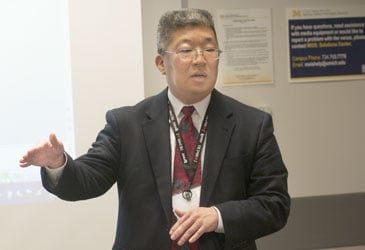A new “teaching electronic health record” (tEHR) from Indiana University School of Medicine will give medical students a chance to learn clinical decision-making and system-based care using real data.
IU cloned its health system’s existing EHR system and scrambled patient data to create the tEHR, then enhanced the design so the technology will send students reminders and information that can affect their clinical decisions.
Blaine Takesue, MD, assistant professor of clinical medicine at the IU School of Medicine (pictured right), presented the tEHR at a special consortium meeting of 11 medical schools that received AMA grants as part of the AMA’s Accelerating Change in Medical Education initiative. The schools met at Vanderbilt University in September to discuss the progress they’re making in preparing tomorrow’s physicians for the rapid changes in medicine.
For example, a student may be undergoing a training activity in which they are using patient data and the tEHR. If a patient in the training activity has renal problems and a student orders a test that could harm the patient’s kidneys, a traditional EHR with clinical decision support would send a warning about the test. But with the tEHR, the student would receive educational content—a video, some text or a link to an outside resource—to help him or her understand why the warning would be sent in the first place.
The tEHR reflects the regulations and constraints that current EHRs offer. That means students will get exposure to things like the meaningful use program and the ICD-10 code set.
“If you’re going to be evaluated based on quality measures, and you don’t understand the qualities of data, you’re going to have to play a lot of catch up,” Dr. Takesue said. “There’s no reason why during medical school we can’t teach our students some of these concepts. We need to impart to our students what EHRs can do, what they can’t do, and what their strengths and weaknesses are.”
The school’s faculty will be able to look at user logs to see how individual students use the tEHR in different patient care scenarios. Because the tEHR uses real data, students also will be able to compare how their clinical decisions matched up with what real physicians actually did in caring for the same patients.
“By using real medical data, one of the lessons we’ll impart to our students is that [health care] decisions can be complicated, and things are sometimes done for different reasons,” Dr. Takesue said.
Dr. Takesue is working with the AMA and the Accelerating Change in Medical Education consortium schools to potentially adapt the tEHR for use at additional medical schools.
This post is the third in a brief series on new medical education technology to be published at AMA Wire® over the coming weeks. See the first post and second post at AMA Wire.




